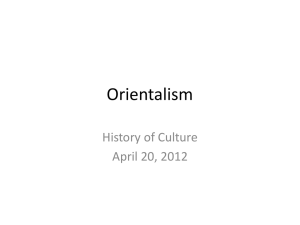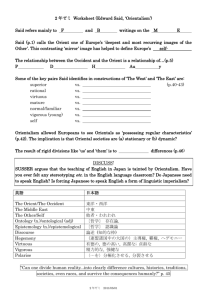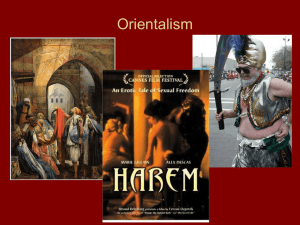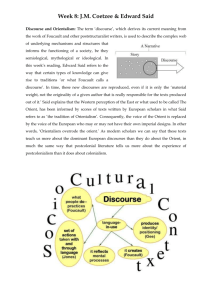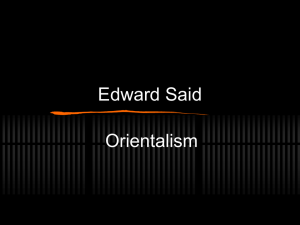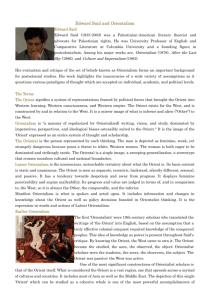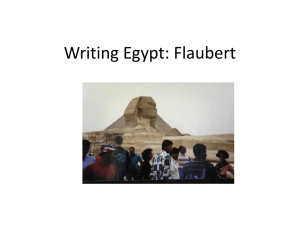Constructing Desire in Nineteenth-Century France
advertisement
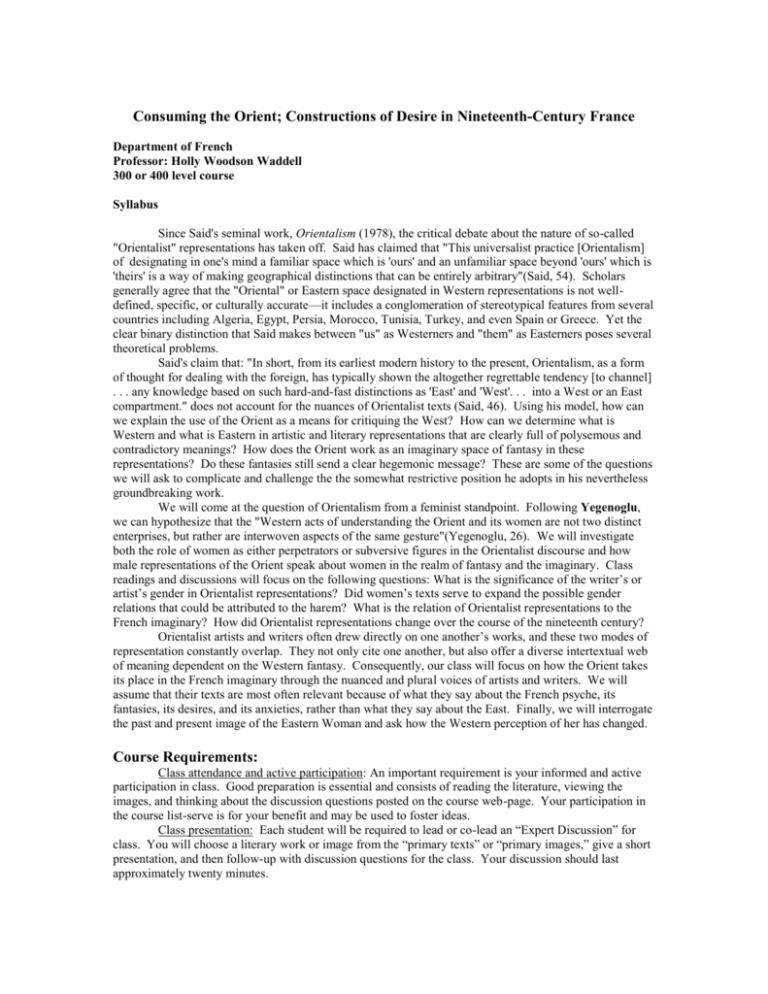
Consuming the Orient; Constructions of Desire in Nineteenth-Century France Department of French Professor: Holly Woodson Waddell 300 or 400 level course Syllabus Since Said's seminal work, Orientalism (1978), the critical debate about the nature of so-called "Orientalist" representations has taken off. Said has claimed that "This universalist practice [Orientalism] of designating in one's mind a familiar space which is 'ours' and an unfamiliar space beyond 'ours' which is 'theirs' is a way of making geographical distinctions that can be entirely arbitrary"(Said, 54). Scholars generally agree that the "Oriental" or Eastern space designated in Western representations is not welldefined, specific, or culturally accurate—it includes a conglomeration of stereotypical features from several countries including Algeria, Egypt, Persia, Morocco, Tunisia, Turkey, and even Spain or Greece. Yet the clear binary distinction that Said makes between "us" as Westerners and "them" as Easterners poses several theoretical problems. Said's claim that: "In short, from its earliest modern history to the present, Orientalism, as a form of thought for dealing with the foreign, has typically shown the altogether regrettable tendency [to channel] . . . any knowledge based on such hard-and-fast distinctions as 'East' and 'West'. . . into a West or an East compartment." does not account for the nuances of Orientalist texts (Said, 46). Using his model, how can we explain the use of the Orient as a means for critiquing the West? How can we determine what is Western and what is Eastern in artistic and literary representations that are clearly full of polysemous and contradictory meanings? How does the Orient work as an imaginary space of fantasy in these representations? Do these fantasies still send a clear hegemonic message? These are some of the questions we will ask to complicate and challenge the the somewhat restrictive position he adopts in his nevertheless groundbreaking work. We will come at the question of Orientalism from a feminist standpoint. Following Yegenoglu, we can hypothesize that the "Western acts of understanding the Orient and its women are not two distinct enterprises, but rather are interwoven aspects of the same gesture"(Yegenoglu, 26). We will investigate both the role of women as either perpetrators or subversive figures in the Orientalist discourse and how male representations of the Orient speak about women in the realm of fantasy and the imaginary. Class readings and discussions will focus on the following questions: What is the significance of the writer’s or artist’s gender in Orientalist representations? Did women’s texts serve to expand the possible gender relations that could be attributed to the harem? What is the relation of Orientalist representations to the French imaginary? How did Orientalist representations change over the course of the nineteenth century? Orientalist artists and writers often drew directly on one another’s works, and these two modes of representation constantly overlap. They not only cite one another, but also offer a diverse intertextual web of meaning dependent on the Western fantasy. Consequently, our class will focus on how the Orient takes its place in the French imaginary through the nuanced and plural voices of artists and writers. We will assume that their texts are most often relevant because of what they say about the French psyche, its fantasies, its desires, and its anxieties, rather than what they say about the East. Finally, we will interrogate the past and present image of the Eastern Woman and ask how the Western perception of her has changed. Course Requirements: Class attendance and active participation: An important requirement is your informed and active participation in class. Good preparation is essential and consists of reading the literature, viewing the images, and thinking about the discussion questions posted on the course web-page. Your participation in the course list-serve is for your benefit and may be used to foster ideas. Class presentation: Each student will be required to lead or co-lead an “Expert Discussion” for class. You will choose a literary work or image from the “primary texts” or “primary images,” give a short presentation, and then follow-up with discussion questions for the class. Your discussion should last approximately twenty minutes. Review essays: Each student must prepare two review essays on selections from the critical or secondary texts. These essays should engage with the ideas in the text and then form an opinion based on your study of the subject at hand. Original, critical essay: In this essay, you will explore more profoundly issues raised in class. I encourage you to start early and to come see me often about your final paper. *All written work should be accompanied by a full bibliography and foot-notes or end-notes using either the MLA or Chicago Manual of Style citation Evaluation: Class attendance and active participation………………………………………….15 % Class presentation (“Expert” discussion)…………………………………………..10% Two short (2-3 pages) review essays………………………………………………15? One longer, original critical essay (15-20 pages) posted to the course web page as hyper-text……………………………………………………60% Primary Images: On reserve in the Library, many on course web-page Bompard, Maurice. Waiting. Bouchard, Paul-Louis. After the Bath, 1889. Delacroix, Eugène. The Death of Sardanapalus, 1844. Cormon, Fernand. Jealousy in the Seraglio, 1874. ---. The Deposed Favorite, Gérôme, Jean-Léon. The Great Bath at Brusa, ---. The Snake Charmer, late 1860’s. ---. Morrish Bath, 1870. ---. The Slave Market, early 1860’s. ---. The Dance of the Almeh, 1863. Ingres, Jean-Auguste-Dominique. The Large Bather, 1808. ---. Zeus and Thetis, 1811. ---. Roger Delivering Angelica, 1819. ---. Odalisque with Slave, 1842. ---. The Turkish Bath, 1863. Manet, Edouard. Olympia, 1863. Post cards? Fromentin? Primary Texts Balzac, Honoré. “La Fille aux yeux d’or.” Baudelaire, Charles. Ecrits esthétiques, Selection. Course Pack. ---. Les Fleurs du mal. Selection. e.g. “Bien loin d’ici,” “Au lecteur,” “Parfum exotique,”“A une Malabaraise,” “Le Voyage.” Course Pack. ---. L’Oeuvre et la vie de Delacroix. Course Pack. Flaubert, Gustave. Salambo --. Voyage en Egypte, Selection. Course Pack. Lamartine, Alphonse de. Souvenirs, impressions, pensées et paysages pendant un voyage en Orient, 1832-1833, Selection. Course Pack. De Lisle, Leconte. Poèmes barbares, Selection. Course Pack. Loti, Pierre. Fantôme d’Orient, Selection. Course Pack. ---. Les dèsenchantées, roman des harems turcs contemporains, Selection. Course Pack. Montagu, Lady Mary Wortley. Letters: Embassy to Constantinople, Selection. Course Pack. Zola, Emile. Au Bonheur des Dames. Secondary and Critical Texts Xerox Selections: Course Pack *see Course Structure, Course Bibliography Course Structure Week 1: Introduction Context and Genesis of Orientalism Week 2: Orientalism and Imperialism Sign up for “Expert Discussion” Images: Overview Required reading: Edward W. Said. Orientalism (Penguin 1995). Additional reading: James Clifford. “Review Essay: Orientalism, by Edward Said,” History and Theory 19 (1980): 204-223. James Clifford. "On Orientalism," The Predicament of Culture: Twentieth Century Ethnography, Literature, and Art (Harvard Press, 1988): Week 3: Gendering Orientalism in Modern France Make an appointment to see me about final paper topics Images: Gérôme Required reading: Flaubert, Salambo, first half. Lisa Lowe. "Orient as Woman." Critical Terrains: French and British Orientalisms (Ithaca: Cornell University Press, 1991): . Additional reading: Judith Butler. "Performative Acts and Gender Constitution: An Essay in Phenomenology and Feminist Theory," Performing Feminisms: Feminist Critical Theory and Theater, ed. Sue Ellen Case (Baltimore: The Johns Hopkins University Press, 1990): . Nupur Chauduri, Beth McAuley, and Ruth Roach Pierson. Nation, Empire, Colony: Historicizing Gender and Race. (Bloomington: Indiana University Press, 1998). Selection Timothy Mitchell, “Orientalism and the Exibitionary Order,” Colonialism and Culture, ed. Nicholas B. Dirks. Meyda Yegenogly. Colonial Fantasies: Towards of Feminist Reading of Orientalism (Cambridge: Cambridge University Press, 1998) Selection. Week 4: Gendering Orientalism Continued: Empire and Industrial Revolution Submit final paper topic, working bibliography Images: Bompard, Bouchard Required reading: Flaubert, Salambo, second half. Reina Lewis. Gendering Orientalism: Race, Femininity, and Representation. (London: Routledge, 1996.) Selection. Additional reading: Margaret Strobel. Gender, Sex, and Empire. 1993. Selection. Week 5: Harem Fantasies and Homoerotics First review essay due Images: Cormon Required reading: Balzac, La Fille aux yeux d’or Bersani on "The Solicitous Gaze" Homos Benjamin, The Work of Art in the Age of Mechanical Reproduction Additional reading: Anne McClintock. Imperial Leather: Race, Gender, and Sexuality in the Colonial Conquest (New York: Routledge Press, 1995). Selection Owen N. Heathcote. "The Engendering of Violence and the Violation of Gender in Honoré de Balzac's La Fille aux yeux d'or." Romance Studies (1993): 99-112. Week 6: The Violence of the Despot: Dreams of Domination Images: Delacroix, Sardanapalus Required reading: Baudelaire, “L’Oeuvre et la vie de Delacroix” Deleuze, Coldness and Cruelty Abigail Solomon-Godeau. Male Trouble: A Crisis in Representation. 1997. Selection Additional reading: Elizabeth Wilson, The Sphynx in the City: Urban Life, the Control of Disorder, and Women (Berkley: University of California Press, 1992). Selection Inge E. Boer. “Despotism from Under the Veil: Masculine and Feminine Readings of the Despot and the Harem,” Cultural Critique 32 (1995-6): 43-73. Ruth Yeazell. "Demystifying the Master," American Literary History. 1993 Elizabeth Abel. "Redefining the Sister Arts: Baudelaire's Response to the Art of Delacroix." Critical Inquiry, 6 (1980): 363-84. David Carrier. "Baudelaire's 'L'Oeuvre et la vie de Delacroix,' Symbolist Painting in an Age of Mechanical Reproduction." Languages of Design: Formalisms for Word, Image, and Sound. 2, no. 4 (1994): 303-23. Week 7: “Ailleurs:” The Elusive Elsewhere Images: Manet. Olympia Required reading: Baudelaire, Les Fleurs du Mal. Selection. Leconte de Lisle. Poèmes barbares. (Paris: Editions Gallimard, 1985). Selection. Walter Benjamin. Charles Baudelaire: A Lyric Poet in the Era of High Capitalism, trans. Harry Zohn (London: New Left Review, 1973). T.J. Clark. The Painting of Modern Life. Additional reading: Mary Anne Stevens. The Orientalists. 1984. Selection Porterfield, Todd. The Allure of Empire: Art in the Service of French Imperialism,1798-1836 (Princeton: Princeton University Press, 1998). Selection Week 8: Exoticism at Home: Putting a Price on Pleasure Second review essay due Images: Ingres, Gérôme Required reading: Zola, Au Bonheur des Dames, first half Elizabeth Wilson. Adorned in Dreams: Fashion and Modernity (Berkley: University of California Press, 1987). Selection. Jann Matlock. "Censored Bodies: Plots, Prostitutes, and the Rêve of 1830," Repression and Expression: Literary and Social Coding in Nineteenth-Century France, ed. Carrol Coates. (1996): Additional reading: Hegel. "The Dialectic of Industrialized Society. " Hegel: The Essential Writings, ed. Frederick Weiss (New York: Harper and Row Publishers, 1974), . Margit Stange. Personal Property: Wives, White Slaves, and the Market in Women. (Baltimore: Johns Hopkins University Press, 1998). Selection. Emily Apter. “Feminizing the Fetish,” Psychoanalysis and Narrative Obsession in Turn-of-theCentury France (London: Cornell University Press, 1991): Carol Ockman. "A Woman's Pleasure: The Grande Odalisque," Ingres's Eroticized Bodies: Retracing the Serpentine Line (New Haven: Yale University Press, 1995). Week 9: Exoticism at Home: Putting a Price on Pleasure, Continued Images: Ingres, Gérôme Required reading: Zola, Au Bonheur des Dames, second half. Rosalind Williams. "The Dream World of Mass Consumption," Rethinking Popular Culture, ed. Chandra Mukerji and Michael Schudson (Berkely: Univeristy of California Press,1982): . Additional reading: Jann Matlock. "Hedonism and Hegemony: Bodily Matters at a Loss," Mosaic (1997): . . . . "The Invisible Woman and Her Secrets Unveiled," Yale Journal of Criticism (1996): . Jurgen Habermas. The Structural Transformation of the Public Sphere: An Inquiry into a Category of Bourgeois Society, trans. Thomas Burger (Cambridge: MIT Press, 1989). Selection Week 10: Womens’ Perspectives on the Orient Images: Ingres, Bain turc Required reading: Lady Mary Wortley Montagu. “Letters.” Embassy to Constantinople. Sara Mills. Discourses of Difference: An Analysis of Women’s Travel Writing and Colonialism (London and New York: Routledge, 1999). Selection. Mary Louise Pratt. Imperial Eyes: Travel Writing and Transculturation (London and New York, Routledge, 1992). Selection. Additional reading: Nupur Chaudhuri, ed. Western Women and Imperialism: Complicity and Resistance. 1992. Selection. Ruth Yeazell. "Public Baths and Private Harems: Lady Mary Montagu and the Origins of Ingres's Bain turc," Yale Journal of Criticism 7, no. 1 (1994):111-38. Week 11: Armchair Travelers and French Odalisques Images: Required Reading: Pierre Lotti. Les dèsenchantées, roman des harems turcs contemporains. Paris: Calmann-Lévy, 1906. Linda Nochlin. "The Imaginary Orient," The Politics of Vision: Essays on Nineteenth-Century Art and Society (New York: Harper and Row Publishers, 1983), . Additional Reading: Donald Rosenthal. Orientalism: The Near East in French Painting 1800-1880. 1982. Irene L. Szyliowicz. Pierre Loti and the Oriental Woman. (New York: St. Martin's Press, 1988). Week 12: Representations of the Real: Documenting Ethnicity Images: Postcards (?) Album de Voyage: des artistes en expédition au pays du Levant, eds. Jean-Louis Andral, Yona Fischer, Jean Lacambre (Paris: Association française d'action artistique: Réunion des musées nationaux, 1993). Required Reading: Flaubert. Voyage en Egypte. Selection. Alphonse de Lamartine. Souvenirs, impressions, pensées et paysages pendant un voyage en Orient, 1832-1833. Selection Pierre Loti. Fantôme d’Orient. Selection. Mallek Alloulah. The Colonial Harem. 1986 Additional reading: Inderpal Grewal. Home and Harem: Nation, Gender, Empire, and the Cultures of Travel. Françoise Chenet. "L'art sarcophage ou la place de l'autre dans la relation de voyage: Trois Artistes sur le Nil: Flaubert, Maxime du Camp, et Fromentin," L'Exotisme, eds., Alain Buisine and Norbert Dodille. (Paris: Didier-Erudition, 1988). Sander Gilman. "Black Bodies, White Bodies: Toward an Iconography of Female Sexuality in Late Nineteenth-Century Art, Medicine, and Literature," Critical Inquiry 12, no. 1 (1985):204-242. Special Session: After Orientalism Viewing of CNN’s documentary, “Behind the Veil” at Professor’s home, dinner and informal discussion Final Paper due during Exam Week Course Bibliography Images Bompard, Maurice. Waiting. Private Collection. Bouchard, Paul-Louis. After the Bath. Private Collection. 1889. Delacroix, Eugène. The Death of Sardanapalus. Louvre, Paris, 1844. Cormon, Fernand. Jealousy in the Seraglio, Musée des Beaux-Arts et d’Archéologie, Besançon, 1874. ---. The Deposed Favorite. Private Collection. Gérôme, Jean-Léon. The Great Bath at Brusa. Private Collection. ---. The Snake Charmer. Sterling and Francine Clark Art Institute. Williamstown, Mass., late 1860’s. ---. Morrish Bath. Museum of Fine Arts, 1870. ---. The Slave Market. Clark Art Institute, early 1860’s. ---. The Dance of the Almeh. 1863. Ingres, Jean-Auguste-Dominique. The Large Bather, Louvre, Paris, 1808. ---. Zeus and Thetis, Musée Granet, Aix-en-Provence. 1811. ---. Roger Delivering Angelica, 1819. ---. Odalisque with Slave, 1842. ---. The Turkish Bath. Louvre, Paris, 1863. Manet, Edouard. Olympia. Musée d’Orsay, Paris, 1863. Post cards? Fromentin? Primary Texts: Balzac, Honoré. “La Fille aux yeux d’or,” Histoire des treize, ed. Pierre Barbéris, (Paris: Flammarion, 1988), 357-449. Baudelaire, Charles. Selections from Ecrits esthétiques, ed. Jean-Christophe Bailly (Paris: Union générale d’éditions, 1986). ---. Selections from The Flowers of Evil, trans. James McGowan (Oxford: Oxford University Press, 1993). Side-by-side translation e.g. “Bien loin d’ici,” “Au lecteur,” “Parfum exotique,”“A une Malabaraise,” “Le Voyage” ---. L’Oeuvre et la vie de Delacroix. Flaubert, Gustave. Salambo (Paris: Editions Gallimard, 1970). --. Selections from Voyage en Egypte. (Paris, Grasset, 1991). Lamartine, Alphonse de. Selections from Souvenirs, impressions, pensées et paysages pendant un voyage en Orient, 1832-1833. (Paris, 1845). De Lisle, Leconte. Selections from Poèmes barbares. (Paris: Editions Gallimard, 1985.) Loti, Pierre. Selections from Fantôme d’Orient. (Paris, 1899). ---. Les dèsenchantées, roman des harems turcs contemporains. Paris: Calmann-Lévy, 1906. Montagu, Lady Mary Wortley. Selections from “Letters.” Embassy to Constantinople, ed. Christopher Pick (New Amsterdam, New Amsterdam Books, 1988). Zola, Emile. Au Bonheur des Dames. (Paris: Booking International, 1994). Secondary and Critical Texts:
